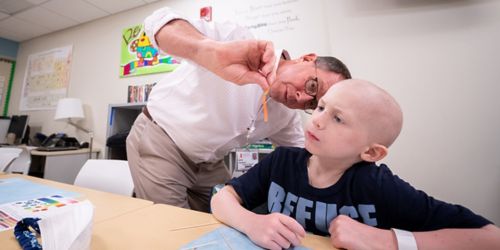St. Jude Family of Websites
Explore our cutting edge research, world-class patient care, career opportunities and more.
St. Jude Children's Research Hospital Home

- Fundraising
St. Jude Family of Websites
Explore our cutting edge research, world-class patient care, career opportunities and more.
St. Jude Children's Research Hospital Home

- Fundraising
The St. Jude School Program’s new principal has learned a thing or two

New St. Jude School Principal Randy Thompson is working with school staff to implement complementary learning models for students to get them to think about real-world issues.
Scientific breakthroughs and history-changing discoveries happen at St. Jude on a regular basis. Who’s to say the next one won’t come from a current patient?
During a recent science camp sponsored by the St. Jude School Program by Chili’s, a group of elementary students conducted tests and recorded their findings. This weeklong event for budding scientists culminated a series of optional camps ranging from art and gardening to photography.
The school’s new principal, Randy Thompson, says the camps offered a taste of project-based learning, customized to each student’s interests and academic needs.
“Project-based learning engages students in a deeper and more connected understanding of their learning by integrating 21st century skills such as critical thinking, collaboration, creativity and communication,” Thompson says. “We’re asking students to think about real issues they’d like to tackle, whether it’s a need in their own communities, or in the world at large. And then we challenge them not just to come up with solutions, but to sell others on their solutions. They have to be able to plan and to present what they’ve learned.”
Thompson acquired his belief in project-based learning through his 20 years in the Memphis and Shelby County School systems, first as a middle school math teacher and then as principal of Snowden School and Idlewild Elementary School.
He says he was excited by the prospect of this new opportunity. His past experience with St. Jude School Program students had demonstrated the quality of the staff and curriculum. He will help Head of School Programs Laurie Leigh shepherd this program into a new era, one enhancing opportunities by expanding its facilities.
“Next year we’ll be operating in a new 10,000-square-foot space,” Thompson explains, showing off a drawing of the new facility. “We’re using 2,000 square feet now. Our new space will provide expanded classroom space and new library and lab exploration areas. We’ll also have a pre-K program for the first time.”
One thing that won’t change is assurance that what they teach aligns with their students’ home school curricula and academic requirements. Whenever possible, the school uses books and assignments from students’ home schools or coordinates with local schools on St. Jude-provided curricula.
Project-based learning extends traditional common core standards and skills, giving students a chance to drive their own learning. This type of learning helps students see the connections between what they learn and how to use this knowledge in the real world. The flexibility also helps them work around their treatment schedules.
“Simply put,” Thompson says, “project-based learning takes learning beyond the traditional classroom, which is a perfect fit for our students at St. Jude. Our goal is for students to take what they have learned while here and implement that learning in their own schools when they return home.”






